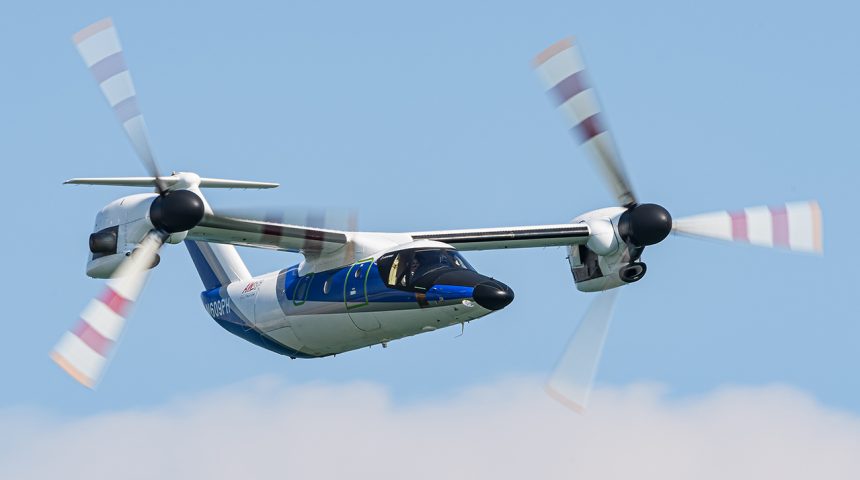The Leonardo AW609 made a public appearance during a recent airshow in Italy. While it prepares to be certified as the world’s first commercial tiltrotor aircraft, it can also be configured for numerous other applications, including Homeland Security, VIP, Utility, Special Operations, Naval and Personnel Recovery.
After a two-year wait, Jesolo Air Show returned with its 2022 edition on Aug. 27 and 28. The show featured 17 different displays, that included Italian Air Force assets, the French Air Force Rafale Solo Display and the Leonardo AW609 tiltrotor. The latter, in particular, was at its debut during an airshow in Italy.
The display of the AW609 drew great interest among the public and the authorities, as they were able to see in action one of the most advanced projects of the Italian helicopter manufacturer, which cements its position in this sector. The AW609 is currently considered, in fact, one of the most significant technological innovations in the global aviation industry and might pave the way for a large-scale diffusion of the tiltrotor platforms.
L’#AW609 di #Leonardo fa il suo ingresso al #Jesolo Air Show: è un aeromobile progettato e costruito per ottenere una sintesi efficace tra la versatilità operativa dell’elicottero e i vantaggi prestazionali propri dell’aeroplano pic.twitter.com/tKxp8UlOeO
— Leonardo (@Leonardo_IT) August 28, 2022
The AW609 was born as a joint Bell and Agusta project, the BA609, which flew for the first time in 2003 as the first civilian tiltrotor aircraft. Later on, Bell pulled out of the project with Agusta, which in the meantime was rebranded as Leonardo Helicopters, continued the development with the plan of introducing the AW609 on the market in the mid-2020s.
The tiltrotor is designed to exploit the advantages of both helicopters and fixed wing aircraft. The result is given by the proprotor nacelles that can be oriented vertically to fly in helicopter configuration and automatically rotated forward, once the right speed is reached, to convert to a fixed wing mode in about 40 seconds. This conversion process transfers the lift from the rotors to the wing, without sudden changes in altitude or flight characteristics as it takes place within an optimal conversion “corridor” automatically managed by onboard computers.
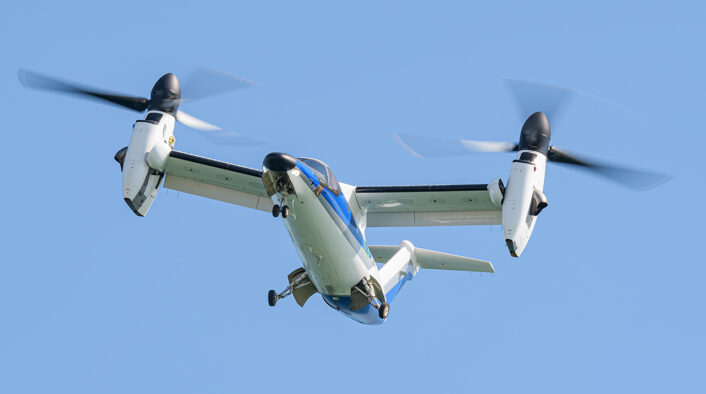
The AW609’s airframe is entirely made of modern composite materials, with a take-off weight of around 8 tonnes. It is powered by two Pratt & Whitney PT6C-67A engines, that allows the tiltrotor to fly at over 275 knots and an altitude of 25,000 ft, with a 1000 nm maximum range that can be increased with auxiliary tanks, all while transporting up to nine passengers plus pilot and co-pilot. The AW609 is designed for flight into known icing conditions and meets the highest FAA requirements for both fixed-wing aircraft and helicopters including single-engine operation and autorotation.
The AW609’s major systems are redundant to ensure smooth operation in case of failure, including a triple digital fly-by-wire (FBW) flight control system which provides excellent manoeuvrability. The cockpit is equipped with an advanced Collins Aerospace Fusion avionics with three liquid crystal touch screens, which are fully Night-Vision Goggle (NVG) compatible.
“What you have with the AW609 is the benefits of both configurations: runway independence and vertical maneuverability of a helicopter as well as the speed, range and altitude performance normally found in turboprop aircraft” told us William Sunick Jr, Senior Manager, AW609 Marketing at Leonardo Helicopters. “This aircraft has a ceiling altitude of 25,000 feet and it’s pressurized unlike almost all the rotorcraft, meaning that it can fly higher and farther, in less turbulent air, avoid obstacles and mountains, reducing fuel consumption of the engines: so it has speed, fuel, altitude and range advantages over the standard helicopters.”
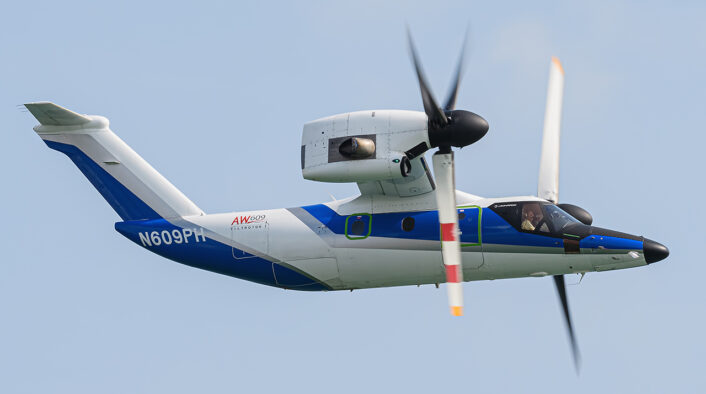
Leonardo is currently developing configurations for different uses of the AW609 tiltrotor. The unique performances are ideal in passenger transport missions, offshore transport in support of the energy supply industry, patrol and surveillance, search and rescue, medical transport, disaster relief, special operations and government tasks.
In time-critical scenarios the tiltrotor’s performance greatly improves response times and coverage area during Search and Rescue (SAR) and Emergency Medical Services (EMS) missions. In these roles, the AW609’s wide cabin door and 600 lb hoist can easily handle a rescue basket, while two stretchers can be quickly loaded for the patients. Up to four medics can provide uninterrupted medical care for a patient in a fully medically equipped cabin.
While initially designed as a commercial aircraft, the AW609 will have an interesting development for military missions where the speed of intervention and the ability to land and take off in confined spaces are required. The primary capabilities that are being looked at see the aircraft configured for numerous applications such as Homeland Security, VIP, Utility, Special Operations and Personnel Recovery.
First time that i see the “Security Service” version of AW609 tiltrotor on Leonardo website. A militarized version of AW609 has been long debated, but now have been added. Leonardo reports tasks as well as for homeland security, but also for SoF operations and personel recovery. pic.twitter.com/1Y2XAMpSMz
— Ciro Nappi (@CiroNappi6) August 28, 2022
The ability to operate more at 500 km offshore adds maritime and border patrol, long-range surveillance, anti-piracy, national waters protection, fisheries control and long-range maritime SAR to the wide range of security roles suited to AW609. In the latter case, the tiltrotor speed and range would allow these missions to be performed with just one aircraft type, without having to rely on multiple aircraft, both fixed and rotary wings, to reach the rescue area in a timely manner.
The development of the AW609 has recently moved significantly closer to US FAA certification. The prototypes used in the flight testing campaign, both in the United States and Italy, have clocked over 1,700 flight hours to date. The final assembly line is based at Leonardo’s US plant in Philadelphia, where also the entire training syllabus and technical support services have also opened. Most of Leonardo’s Italian factories are involved as well, producing key components for the final assembly.
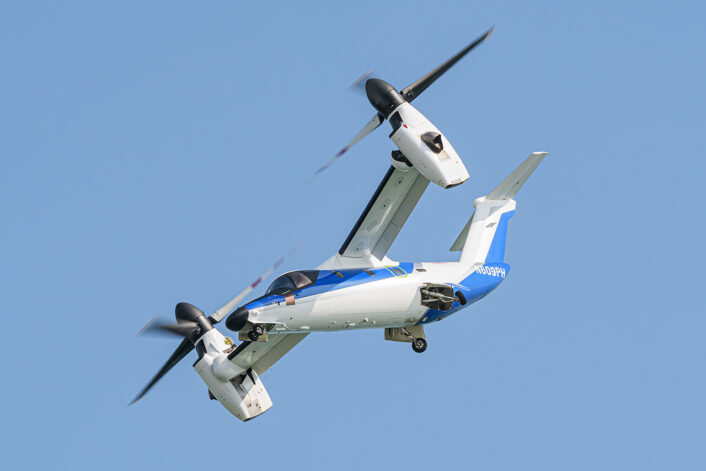
Bristow Group, the global leader in vertical lift solutions, is the launch customer for the AW609. Leonardo and Bristow Group will collaborate to introduce the AW609 aircraft into service and define mission capabilities, assessing concepts of operations, regulations, maintenance, configuration optimization and possible areas of enhancement or modifications. The first Bristow aircraft is already in the final stages of production.
Significant interest for the AW609 exists in areas such as Australia and Japan. Several studies have been carried out in Australia to employ the tiltrotor in the health sector. The aircraft would allow to quickly reach remote areas of the national territory and then transport patients directly to the hospital without having to resort to the mix of aircraft capable of landing on semi-prepared runways and ambulances at the airport.
The Tokyo Metropolitan Government also announced the intention to evaluate the AW609 to provide a faster transportation to Ogasawara island in the future, which sits approximately 1000 km from Tokyo. Missions would be performed in all weather conditions and with limited infrastructural impact thanks to its helicopter-like footprint, which would not require new infrastructures to be built on the island.
Last year, the same AW609 prototype that was displayed at Jesolo Air Show, was presented to the public for the first time outside the USA and Europe, at Dubai Air Show and during Expo2020. The tiltrotor was flown there also for the opening ceremony of the new helicopter terminal, built by Leonardo in partnership with Falcon Aviation Services, at the Expo 2020 Dubai site.
Many operators are reportedly interested in the tiltrotor also for passenger and VIP transportation, especially in the Middle East, where Leonardo has a strong presence. Earlier this year, an order was announced for four AW609s destined for an unspecified private operator in Europe for passenger transport tasks.
At Farnborough International Airshow 2022, we had a chance to talk to Clyde Woltman, CEO of Leonardo Helicopters U.S.. Woltman has a significant experience as a Marine and Naval Aviator, flying the AV-8 Harrier aircraft during combat operations and as the commander of the 11th Marine Expeditionary Unit AV-8B Harrier Detachment, Marine Attack Squadron 311, and Marine Aircraft Group 13. Mr. Woltman’s experience spans from Operation Desert Storm to Southern Watch, Iraqi Freedom and Iraqi Freedom II during those he totalled 200 combat missions.
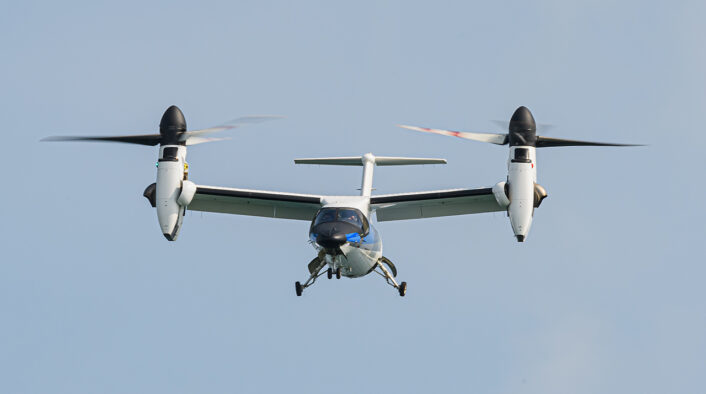
“I’m a power lift pilot, flying the AV-8B and commanding a squadron and an Air Group, hence I’m very sensitive and partial to the ability to fly an aircraft in vertical and airplane mode. And I’m also very fond of the tiltrotor technology, as a retired Marine, considered what the V-22 has done for us in a combat environment. That being said, it’s an honour for me to be part of an organization that is leading in this field as the ability to fly vertical and put the aircraft on the wing in the single mission is phenomenal. It opens so many doors, for so many customers, in the commercial side, EMS, long-range SAR, etc: for instance, to rescue someone at sea you would typical need to deploy a couple of aircraft. This tiltrotor aircraft can get there quickly, recon over the area, find whatever/whoever you need to find and execute a mission as it was a helicopter. And this is a tremendous capability.”
“From a pilot perspective, this aircraft is extremely user-friendly and very forgiving. I was impressed by its abilities when we did an emergency [in the simulator] we cut an engine and we were able to do a heavy take off from the top of a building with minimal impact and did also an emergency landing. This is an extremely capable and versatile aircraft” Woltman said.
Woltman strongly believes tiltorotor technology will be even more relevant in the future, as it will be available to support new use cases. “This is just the beginning, in the future we will see bigger and better more capable tiltrotor aircraft. The advantage of vertical takeoff is there, won’t go away. The transition from that to get from Point A to Point B quickly, tis enabled by being able to put the aircraft on the wing. That’s fantastic.”
An AW609 trainer was also on display at FIA 22, where we had a chance to test it. Here below is a short video filmed during our training session at the simulator:
View this post on Instagram

